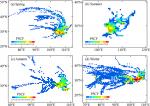Citation:

摘要:
Seasonal pattern of transport pathways and potential sources of PM2.5 in Chengdu during 2012–2013 were investigated based on hourly PM2.5 data, backward trajectories, clustering analysis, potential source contribution function (PSCF), and concentration-weighted trajectory (CWT) method. The annual hourly mean PM2.5 concentration in Chengdu was 97.4 mg·m–3. 5, 5, 5 and 3 mean clusters were generated in four seasons, respectively. Short-distance air masses, which travelled within the Sichuan Basin with no specific source direction and relatively high PM2.5 loadings (>80 mg·m–3) appeared as important pathways in all seasons. These short pathways indicated that emissions from both local and surrounding regions of Chengdu contributed significantly to PM2.5 pollution. The cities in southern Chengdu were major potential sources with PSCF>0.6 and CWT>90 mg·m–3. The northeastern pathway prevailed throughout the year with higher frequency in autumn and winter and lower frequency in spring and summer. In spring, long-range transport from southern Xinjiang was a representative dust invasion path to Chengdu, and the CWT values along the path were 30-60 mg·m–3. Long-range transport was also observed in autumn from southeastern Xinjiang along a northwesterly pathway, and in winter from the Tibetan Plateau along a westerly pathway. In summer, the potential source regions of Chengdu were smaller than those in other seasons, and no long-range transport pathway was observed. Results of PSCF and CWT indicated that regions in Qinghai and Tibet contributed to PM2.5 pollution in Chengdu as well, and their CWT values increased to above 30 mg·m–3 in winter.
